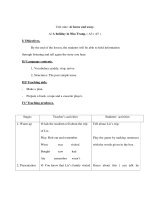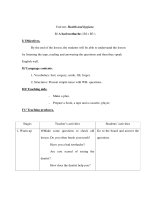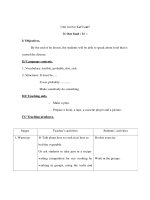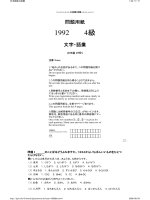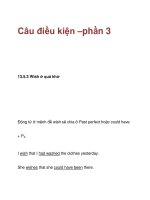Quantitative comparisons practice phần 3 pps
Bạn đang xem bản rút gọn của tài liệu. Xem và tải ngay bản đầy đủ của tài liệu tại đây (107.71 KB, 18 trang )
19.
A:
3
2
3
1
B:
5
3
1
The best answer is B.
The power of 1/3 in column A is 6 while in column B its 5 and we know
that dealing with fractions, the smallest the power the largest the
expression and so column B is greater.
20.
A:
2
2
X
Y
B:
X
Y
AI: X
2
Y
3
> 0
XY < 0.
The best answer is A.
From X
2
Y
3
> 0, we know that Y is positive and using the data that XY <
0 we can conclude that X is negative.
The expression in column A is positive.
The expression in column B is negative and so column A is greater.
C. Absolute value
21.
A: YX
B: YX
AI: X < 0 < Y < 1
The best answer is A.
Plug in numbers that fit, for example: X= -1 and Y= ½.
Column A = 1.5 and column B = ½ and so column A is greater.
22.
A: 7Y
B: Y7
AI: Y < -2
The best answer is C.
The easiest way is to plug some numbers.
For example: Y = -4.
Column A = 11 and column B = 11 and so both columns are equal.
23.
A: 7Y
B: Y7
AI: Y < -7
The best answer is C.
The easiest way is to plug some numbers.
For example: Y = -8.
Column A = 15 and column B = 1 and so column A is greater.
24.
A:
4X
B:
7Y
AI: Y < X < 0
The best answer is B.
The easiest way is to plug in numbers.
For example: X= -1 and Y= -2.
Column A = 6 and column B = 9 and so column B is greater.
25.
A:
5R
B: R + 5
AI: R < 0
The best answer is D.
Take R = -5, both columns end up zero.
Take R = -10, column A is greater and so the answer cannot be
determined.
26.
A: 3S
B: S + 3
AI: S < -3
The best answer is A.
Take a representative number, for example S = -5.
Column A = 2 and column B = -2 and therefore column A is greater.
27.
A: 17Z
B: Z – 17
AI: Z >17
The best answer is C.
Both expressions will always be positive and so the absolute value has no meaning.
Both columns are equal.
28.
A:
YX
B: 12
AI: Y
2
= 12
X
2
= 3
The best answer is B.
From the additional data we can conclude that: 12Y and 3X .
The expression in column A =
636
and therefore column B is greater.
29.
A: 1
B: X
AI:
X
X
2232
The best answer is A.
Simplify the expression:
X
X
2232
X
X
2
2
5
XX 5 .
Plug in X = 1, we can see that the inequality is wrong and so X must be smaller than
1.
Therefore column A is greater than column B.
30.
A: -2
B: Y
AI:
2
3381
Y
Y
The best answer is D.
Simplify the expression:
2
3381
Y
Y
YYYY
Y
Y
22433
2
4
.
Only Y smaller than -1 will validate this inequality and therefore -2 is one of them.
Y can be -2 or even -8 and so the answer is not distinct.
31.
A: Y
B: 0
AI: XXYXY
The best answer is B.
X is bigger than an absolute value and therefore X is positive.
XY is negative and therefore Y must be negative.
Column B is greater than column A since 0 is bigger than any negative number.
32.
A:
XX
B: -X
2
AI: X < 0
The best answer is C.
The easiest way if you don’t see the answer right away is to plug in numbers.
Take X= -2, column A = -4 and so is column B.
33.
A: 1
B: a
AI: bba
The best answer is A.
b is positive since it is larger than an absolute value.
a can’t be positive, because then the left hand side would be larger than the right hand
side. a can’t be zero because then both sides would be equal the only option left is
that a must be negative and so column A is greater.
34.
A: 0
B: T
AI: TT
The best answer is D.
From the additional data we can conclude that T is greater or equal to zero and
therefore we cannot determine which column is greater.
35.
A: X
3
B: X
2
AI:
0 YX
The best answer is B.
Since
0 YX
, X must be the factor that makes the inequality negative.
The expression in column A is negative while the expression in column B is positive
and thus greater.
D. Powers and simplifications
36.
A: (Y – 2)
2
B: 2 – Y
AI: 0 < Y < 1
The best answer is A.
(Y – 2)
2
? 2 – Y
-(Y – 2)(2 – Y) ? 2 – Y
2 – Y ? 1
2 – Y is greater than Y in the specified range and so the answer is A.
37.
A:
YX
1
1
2
B:
XY
1
1
2
AI: X > 0
1
Y
The best answer is C.
1 by any power is 1 and therefore the columns must equal to one another.
38.
A: (W + 1)
2
B: (W + 2)
2
The best answer is D.
Simplify the expressions:
W
2
+ 2W + 1 ? W
2
+ 4W + 4 subtract common items from both sides.
0 ? 2W + 3
We don’t know if W is positive or not and therefore the answer cannot be determined.
39.
A: W – Z
B: X – Y
AI: X < W
Z < Y
The best answer is A.
Add Y – W to both columns to get: A = Y – Z and B = X – W.
These are easier to compare, Y > Z and so column A is greater.
40.
A:
XX 2
)5(5
B:
XX 2
5)5(
AI: X is a positive and odd number.
The best answer is A.
Column A = (+)(+) since (-5) is powered by an even power.
Column B = (-)(+) and so column A is greater than column B.
41.
A: (-5)
X
B: (-5)
X+1
AI: X is a positive and even integer
The best answer is A.
Column A = (-5)
X
and column B = (-5)
X
(-5).
Plug in X = 2 to get:
A = 25 and B = -125 and so column A is definitely greater.
42.
A: 0
B: Z
AI: X < Y
ZX < ZY
The best answer is B.
If Z was negative the inequality ZX < ZY would be opposite and therefore we can
conclude that Z is positive and thus greater than zero.
Column B is greater than column A.
43.
A: 0
B: P
2
– 1
AI: 3
P+2
= 81
The best answer is C.
3
P+2
= 81 = 3
3
P + 2 = 3 P = 1.
Column A = 0.
Column B = 1 – 1.
Both columns are equal and so the answer is C.
44.
A: 5
B: Y
AI: 2
Y-1
= 32
The best answer is B.
32 = 2
5
= 2
Y – 1
5 = Y – 1 Y = 6.
Column A = 5.
Column B = 6.
Column B is greater than column A and so the answer is B.
45.
A: 3
B: Q
AI: 33
(Q+3)
= 1
The best answer is A.
Any number by the power of zero is 1 and therefore we want that Q + 3 =0 and so Q =
-3.
Column A = 3 and column B = -3 and the answer is A.
46.
A:
19
A
B:
9
1
3
1
3
A
The best answer is C.
Simplify each of the expressions.
Column A =
2
4
2
1
19
AAA
.
Column B =
2
3
2
3
9
1
3
1
3
AAA
.
We can see that both columns are equal.
47.
A:
2
55
X
B:
2
5
X
AI: X < -2
The best answer is
Simplify each of the expressions.
A = 5
X+2
.
B = 5
2X
.
Plug in X = -4 for example.
A = 5
-2
= 1/25.
B = 5
-8
= 1/(5
8
), which is a lot smaller than column A and so the answer is A.
48.
A:
X
2
3
B:
X
33
2
AI: 1 < X < 2
The best answer is B.
3
2X
? 3
2+X
2X ? 2+X
X ? 2
2 is greater than X and therefore column B is greater.
49.
A:
3
1
6
6
B:
3 19
6
The best answer is C.
Take the expression in column B and simplify it:
3
1
6
3
19
3 19
666
.
We can see that the columns are equal.
50.
A: 3
6
B: 6
3
The best answer is A.
I think the easiest way here is to write the expressions in the following form:
A = 3
3
x 3
3
B = (2 x 3)
3
= 2
3
x 3
3
, we can see that the expression in column A is greater.
51.
A: 5
6
B: 5
7
- 5
1
The best answer is B.
Divide both sides by 5
6
:
1 ? 5 – 5
-5
5
-5
? 4
4 is much greater than 5
-5
and therefore the answer is B.
52.
A: (A + 4)
2
B: (A – 4)
2
AI: 1 < A < 4
The best answer is A.
(A + 4)
2
? (A – 4)
2
A
2
+ 8A + 16 ? A
2
– 8A + 16 subtract A
2
+ 16 from both sides.
8A ? -8A
16A ? 0
A is positive and so column A (16A) is greater.
53.
A: 8X – 3Y
B: 6X + 5Y
AI: X > 2
Y = 0.5
The best answer is A.
First replace Y with 0.5:
8X – 1.5 ? 6X + 2.5 Add 1.5 – 6X to both sides.
2X ? 4.
Since X is greater than 2, column A is greater than column B.
54.
A: X
B: -1
AI: X
X
21
4
26
The best answer is A.
Simplify the expression in the additional data: XXX
X
842621
4
26
.
6X = -2 X = -1/3, which is larger than -1 and therefore column A is greater.
55.
A: 13 + 2X
B: 3.5X + 7
AI: X > 5
The best answer is B.
13 + 2X ? 3.5X + 7 subtract (7 + 2X) from both sides.
6 ? 1.5X.
The expression in column B can be 9 and up and therefore column B is greater.
56.
A: 7 – 3Y
B: 2Y – 13
AI:
3
Y
The best answer is A.
7 – 3Y ? 2Y – 13 Add 3Y + 13 to both sides.
20 ? 5Y
Column B can be 15 at most and therefore column A is greater.
57.
A:
11
XX
ba
B:
2
1
b
AI: 1
ba
The best answer is C.
From the extra data we know that a = 1/b.
Simplify the expression in column A:
2
2111
1
11
11
b
bbbb
b
ba
XXX
X
XX
.
We can see that both columns are equal.
58.
A: Y
B: ¼
AI: XY = 2
X
3
Y
3
Z
3
= X
4
Y
5
Z
3
0
Z
The best answer is A.
Take X
3
Y
3
Z
3
= X
4
Y
5
Z
3
and divide both sides by Z
3
: X
3
Y
3
= X
4
Y
5
Replace XY with 2: 2
3
= 2
4
Y Y = ½ and therefore column A is greater.
59.
A: X
B: ½
AI:
322
)(XXX
XX
X > 1
The best answer A.
63322
)( XXXXX
XXX
.
Compare the powers: 3X = 6 X = 2.
Column A is greater than column B.
60.
A: 160
B:
7
810
18
63
The best answer is B.
There is only one way to solve this problem (guessing doesn’t count):
16262763
6
6
3
3
36
63
18
63
3
7
8
7
10
7
810
7
810
.
Column B is greater than column A.
1.
A:
4
1
6
5
3
1
B:
4
1
14
6
7
6
The best answer is B.
Take each column and reduce it to one variable.
Since both sides have the variable ¼ subtract it from both sides.
Reduce column A to
6
7
12
14
24
28
24
208
6
5
3
1
.
Column B can be written as
7
9
14
18
14
612
14
6
7
6
.
Again, it’s still hard to compare and so we’ll find another common denominator.
42
54
7
9
42
49
6
7
And so column B is greater.
2.
A:
5
4
5
4
B:
5
4
5
4
The best answer is A.
A can be simplified to 8/5.
B can be simplified to 16/25, which is definitely smaller than column A.
3.
A:
24
9
15
12
21
6
B:
15
14
3
1
2
1
The answer is B.
We can write column B as
15
14
21
7
24
12
. We can see that all the variables in column
B are greater than those in column A and therefore the answer is B.
4.
A: 14 percent of 50
B: 15 percent of 51
The best answer is B.
A can be written as 7
100
700
50
100
14
.
B can be written as
100
765
51
100
15
, and therefore column B is greater.
5.
A: 17 percent of 300
B: 15 percent of 312
The best answer is A.
A can be written as 300
100
17
and B can be written as 312
100
15
.
Since the denominator of both columns is the same we can only compare the
numerator, divide both numerators by 15 to get:
A: 17 x 20, which is 340 and B: 312.
We can see that A is greater.
6.
A: Q
5
B: 3Q
2
AI: 2Q
3
= -432
The best answer is B.
In this question you don’t really need to calculate the actual numbers only pay
attention to signs. From the additional data we can conclude that Q is negative since
the power is odd. A will result in a negative number but B has an even power and so
the result is positive.
7.
A: 3X
B: X
2
AI: X
4
= 81
The best answer is D.
From the additional data we can conclude that X is 3 or -3.
If X = 3, than A Is greater but if X = -3, B is greater and so the answer cannot be
determined.
8.
A: P
2
B: 2P
AI: P is a prime number between 1 and 4 inclusive
The best answer is D.
Since P can be 2 and also 3, the answer cannot be determined.
If P = 2, A = 4 and B = 4 but if P = 3, A = 9 and B = 6 and therefore the answer
cannot be determined.
9.
A: Y
B: 5
AI: -5 < Y < 5
The best answer is B.
The range of Y does not include 5 and therefore 5 is a number that is always greater
than Y.
10.
A: B
B: 2
AI: A < B < C
A, B and C are positive prime numbers.
C = 3
The best answer is C.
From the additional data we can conclude that A = 1, B = 2 and C = 3 and therefore
both columns are equal.
11.
A: The unit’s digit of X
B: 3
AI: In a three digit positive integer X, the hundreds’ digit is four times the units’ digit.
The best answer is B.
If the hundreds’ digit is four times the units’ digit, then the unit digit can be 2 or
smaller (if its 3, than the hundreds’ digit is bigger than 9, which is not possible) and
therefore column B must be greater.
12.
A: The units’ digit
B: 9
AI: In the three digits number Y, the units’ digit is two times greater than the tens’
digit and four times greater than the hundreds’ digit.
The best answer is B.
Using the additional information, we have two options: 124 and 248, in both cases 9
is greater than the unit’s digit and so the answer is B.
13.
A: The perimeter of a square with an area of 20
B: The perimeter of a square with side 4.5
The best answer is A.
The question is about, which square has the largest side.
The square of column A has a side of 20 .
The square of column B has a side of 4.5 and so the area is
25.205.4
2
and
therefore its perimeter is also greater.
14.
A: The area of a square with side 2
B: The area of a circle with a radius of 1.5
The best answer is B.
The area of the square is 4, compare it with the area of the circle.
The area of the circle is
2
R
, which is equal to approximately
425.214.35.114.3
2
and therefore column B is greater.
15.
A: X + Y
B: 2Y
AI: 1.5X = ZY
2
3
7
6
Z is negative
The best answer is B.
Replace X and Y with Z.
X = Z, Y = Z
12
21
.
Column A is equal to Z +
ZZ
12
33
12
21
and column B is equal to
Z
12
42
, which is
greater and so B is the answer.
16.
A: Q + 2W – P
B: 2P + 2Q
AI: 0.5Q = 1.5W = 2P
The best answer is
Replace Q and W with P.
Q = 4P, W = 4P/3.
Column A can be written as 4P + 8P/3 – P = P/3.
Column B can be written as 2P + 8P = 10P, which is greater than column A.
17.
A: The average (arithmetic mean) of the two numbers.
B: 3
AI: The product of two integer numbers is 15.
The best answer is D.
If the product of the two numbers is 15 then they can be 15 and 1 or 3 and 5, the
average of both pairs is bigger than 3 and so it seems like the answer is A. Don’t be
mistaken, you were not told that the numbers were positive and so they can also be -5
and -3, with an average smaller than 3.
18.
A: The average (arithmetic mean) of the two numbers.
B:
3
1
3
AI: The product of two positive numbers is 10
The best answer is D.
The product of the two numbers is 10 and so they can be 2 and 5, 1 and 10 and even
10 and 10 . In the first two cases the average is bigger than column B but the
average of the third case is 10 , which is smaller than
3
1
3 and so the answer is D.
19.
A: The average (arithmetic mean) of the three numbers.
B: 5
AI: The product of three integer positive numbers is 12.
The best answer is B.
There are many combinations of numbers which their product is 12:
(1, 1, 12), (3, 4, 1), and (6, 2, 1).
The average of all three combinations is smaller than 5.
20.
A: The remainder is when n + 2 is divided by 8
B: 7
AI: The remainder when n-1 is divided by 10 is 0, and the remainder when n+1 is
divided by 18 is 4.
The best answer is C.
Using the additional data we can conclude that n is equal to 21.
According to column A, the remainder is (23/8 = 7), which is equal to column B.
21.
A: The remainder is when n - 3 is divided by 6
B: 4
AI: The remainder when n+1 is divided by 9 is 5, and the remainder when n-1 is
divided by 5 is 2.
The best answer is C.
Using the additional data we can conclude that n is equal to 13.
According to column A, the remainder is (10/6 = 4), which is equal to column B.
22.
A: The remainder is when n + 7 is divided by 17
B: 9
AI: The remainder when n+3 is divided by 9 is 4, and the remainder when n-1 is
divided by 5 is 1.
The best answer is A.
Using the additional data we can conclude that n is equal to 37 for example.
According to column A, the remainder is (44/17 = 10), which is greater than column
B.
23.
A: X
B: 4
AI: The average (arithmetic mean) grade point average of X students is 86.
The average of these X students together with a score of 92 is 88.
The best answer is B.
Let’s write the average of the X students with the extra grade:
88
1
9286
X
X
86X + 92 = 88X + 88 2X = 4 X = 2.
24.
A: Y
B: 3
AI: The average (arithmetic mean) age of Y family members is 20.
When a new baby was born (assume that his age is 0), the new average
Was 15.
The best answer is C.
Use the average formula: 15
1
020
Y
Y
20Y = 15Y + 15 Y = 3.
25.
A: 12
6
+ 12
7
B:
6
1213
The best answer is C.
Remember, compare don’t calculate.
A can be written as 12
6
+ 12 x 12
6
= 13 x 12
6
, which is equal to column B.
26.
A: 8
7
x 4
3
B: 4
12
The best answer is A.
A can be written as 2
3x7
x 2
2x3
= 2
27
.
B can be written as 2
2x12
= 2
24
, which is smaller than column A.
27.
A: AB
B: BO
AI: O is the centre of the circle
The best answer is A.
Don’t let the proportions of the drawing fool you.
Since O is the centre of the circle, both triangles are isosceles and so the angle which
is closer to the origin is (180 – 45 – 45 = 90). AB is the side that is in front of the 90
degree angle and so it’s the hypotenuse.
28.
A: The original number of Girls in the playground
B: 16
AI: After 5 girls leave the playground; there are three times as many boys than girls.
After 25 more boys leave the playground, there are twice as many girls than boys.
The best answer is B.
Let G be the number of girls and B the number of boys.
We can write the following equations:
3(G – 5) = B and 2(B – 25) = G – 5 .
From these two equations, we can find that G = 15 and so the answer is B.
29.
A: The original number of cats in the yard
B: The original number of dogs in the yard
AI: After 7 dogs leave the yard, there are two times as many cats than dogs. After a
further 16 cats leave the yard, there are two and a half as many dogs as cats.
The best answer is A.
Let D be the number of dogs in the yard and C the number of cats.
We can write the following equations:
2(D – 7) = C and (D – 7) = 2.5(C – 16)
Solving these equations, D = 17 and C = 20.
And therefore the answer is A.
30.
A: The number of yellow papers in the pile
B: 120
B
A
45
O

